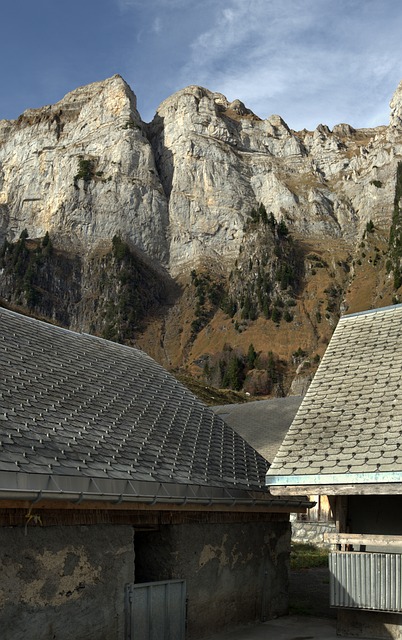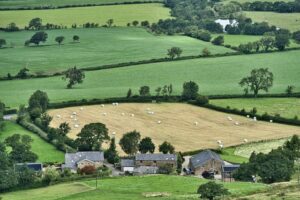Optimizing Bathurst’s Agriculture: The Role of Durable Farm Sheds for Livestock and Efficiency
Farm sheds in Bathurst, New South Wales, are crucial multifunctional structures integral to the region's agricultural success. These sheds protect livestock and store equipment, with designs tailored to withstand local climates, from harsh…….

Farm sheds in Bathurst, New South Wales, are crucial multifunctional structures integral to the region's agricultural success. These sheds protect livestock and store equipment, with designs tailored to withstand local climates, from harsh winters to scorching summers, using materials like galvanized steel or treated timber. Modern farm sheds are equipped with features that enhance sustainability, such as natural light sources, efficient ventilation systems, and designs that support animal well-being and environmental efficiency. Advanced technologies in these sheds facilitate health monitoring, feeding, and watering systems, which also contribute to energy savings through solar panels and proper insulation. Compliance with local regulations ensures that farm sheds meet stringent welfare and safety standards, reflecting Bathurst's commitment to eco-friendly and technologically advanced farming practices. These innovations position Bathurst as a leader in sustainable livestock management, setting a benchmark for the industry through improved productivity and operational efficiency.
Explore the significance of farm sheds in the agricultural landscape of Bathurst, New South Wales, through a comprehensive examination of their role, design, and benefits. This article delves into the crucial aspects of constructing durable livestock sheds tailored to Bathurst’s climate, highlighting modern advancements that improve livestock welfare and operational efficiency. Gain insights into the regulatory framework guiding these structures and learn from local case studies that demonstrate best practices and key lessons in managing successful farm shed operations in Bathurst. Join us as we shed light on the pivotal role of farm sheds in NSW agriculture, emphasizing their importance in contemporary farming practices.
- Understanding the Role of Farm Sheds in Bathurst, NSW Agriculture
- Design and Construction Considerations for Durable Livestock Sheds in Bathurst's Climate
- The Benefits of Modern Farm Sheds for Enhancing Livestock Welfare and Efficiency in Bathurst
- Regulatory Framework and Best Practices for Building Livestock Sheds in Bathurst
- Case Studies: Successful Livestock Shed Operations in Bathurst, NSW and Lessons Learned
Understanding the Role of Farm Sheds in Bathurst, NSW Agriculture

In the diverse agricultural landscape of Bathurst, New South Wales, farm sheds stand as indispensable structures that support the thriving agrarian economy. These aren’t mere shelters; they are multifunctional spaces pivotal for a variety of purposes, from housing livestock to storing machinery and fodder. The region’s farms rely on these sheds to protect animals from harsh weather conditions, provide safe birthing environments, and facilitate efficient farming practices year-round. These structures are designed to meet the specific needs of the Bathurst terrain, accommodating the varying climatic demands and ensuring the welfare of the livestock. Moreover, farm sheds contribute significantly to the organization and productivity of agricultural activities by offering ample space for hay storage, crop drying, and machinery maintenance. They are a testament to the ingenuity and resilience of Bathurst’s farmers, who continuously adapt their practices to optimize yield and sustainability.
The significance of farm sheds in Bathurst extends beyond their immediate utility; they play a crucial role in the economic stability of the region. As Bathurst’s agricultural sector evolves with advancements in technology and farming methods, these sheds are often retrofitted or replaced with modern, robust designs that can withstand the elements while accommodating cutting-edge farming technologies. This commitment to infrastructure not only underscores the importance of farm sheds in the day-to-day operations but also highlights their role as an integral component in the broader context of Bathurst’s agricultural prosperity and innovation.
Design and Construction Considerations for Durable Livestock Sheds in Bathurst's Climate

In Bathurst, NSW, the design and construction of farm sheds must consider the region’s unique climatic conditions to ensure durability and functionality over time. The sheds should be robust enough to withstand harsh winds and heavy snowfall that can occur during the winter months, as well as the heat waves characteristic of the Australian summer. Utilizing materials like galvanized steel or treated timber provides a strong foundation for withstanding the elements. Design features such as high roof pitches aid in ventilation and prevent water pooling, while strategic placement of the sheds on the farm can protect livestock from prevailing winds and extreme temperatures.
To further enhance durability, consider incorporating designs that allow for natural light and improved airflow, which not only benefit the livestock but also contribute to energy efficiency. Additionally, integrating a well-thought-out drainage system is crucial to ensure that water flows away from the structure, reducing the risk of damage during heavy rainfall. In Bathurst, farm sheds are more than just shelters; they are vital infrastructure that necessitates careful planning and execution to endure the region’s demanding climate. By investing in high-quality materials and design considerations tailored to local conditions, farmers can ensure their livestock sheds remain a stalwart asset on their properties for years to come.
The Benefits of Modern Farm Sheds for Enhancing Livestock Welfare and Efficiency in Bathurst

In Bathurst, NSW, modern farm sheds represent a significant advancement in the management and welfare of livestock. These structures are designed with the latest agricultural technologies and materials to provide optimal living conditions for various species. The strategic placement of natural light sources and ventilation systems in these farm sheds enhances animal comfort, reduces stress, and promotes healthy growth, which is crucial for maintaining high standards of livestock welfare. Additionally, the design often incorporates ample space for movement, which allows animals to exhibit natural behaviors, further contributing to their well-being.
Farmers in Bathurst are recognizing the efficiency benefits that come with investing in modern farm sheds. These buildings not only house livestock safely but also streamline operations through integrated systems that facilitate easier management of feeding, watering, and health monitoring. The use of durable materials ensures longevity, minimizing maintenance costs and downtime. Moreover, the energy efficiency features of these sheds, such as solar panels and insulation, significantly reduce energy expenses and carbon footprint, aligning with sustainable agricultural practices. This alignment not only benefits the farm’s bottom line but also positions Bathurst farmers at the forefront of eco-friendly farming, a model that is increasingly important in today’s market.
Regulatory Framework and Best Practices for Building Livestock Sheds in Bathurst

In Bathurst, New South Wales, constructing farm sheds for livestock necessitates adherence to a robust regulatory framework that ensures both animal welfare and compliance with local and state building standards. The Local Environment Plans (LEPs) and development control plans (DCPs) set forth by Bathurst Regional Council provide the necessary guidelines for the design, construction, and operation of farm sheds. These documents outline specifications for size, materials, location, and environmental considerations to minimize impact on surrounding land and ecosystems.
Best practices in building livestock sheds in Bathurst emphasize durability, functionality, and adaptability to various climatic conditions. The use of high-quality, weather-resistant materials is crucial for the longevity of the shed. Additionally, incorporating features such as natural ventilation, adequate lighting, and easy access for livestock movement are essential for maintaining animal health and comfort. Farmers should also consider the integration of modern technologies like automated feeding systems or climate control mechanisms to enhance the productivity and efficiency of their operations. Compliance with the Australian Standards (AS 4576) for the design, installation, and maintenance of sheds housing animals ensures that these structures meet both safety and welfare requirements. Engaging with local agricultural extension services can provide tailored advice and support throughout the construction process, ensuring that farm sheds in Bathurst are not only compliant but also optimized for the unique needs of the region’s farming community.
Case Studies: Successful Livestock Shed Operations in Bathurst, NSW and Lessons Learned

In Bathurst, New South Wales, farm shed operations have evolved significantly, with a number of local farms achieving remarkable success through innovative design and management practices in their livestock sheds. These sheds are not merely structures for housing animals; they are pivotal to the health, productivity, and welfare of livestock. For instance, ‘Farm A’ near Bathurst has implemented advanced ventilation systems within their farm sheds, allowing for optimal temperature control and reduced stress on the animals. This has resulted in improved feed efficiency and growth rates, demonstrating the significance of environmental considerations in modern farm shed design.
Another case study worth noting is ‘Farm B’, which has successfully integrated technology with traditional farming practices. Their use of automated feeding systems, coupled with strategic shed layouts that facilitate easy management and monitoring, has led to increased milk production and better herd management. The lessons learned from these operations underscore the importance of investing in durable farm sheds equipped with modern technologies to enhance productivity and sustainability. The integration of best practices in terms of biosecurity, animal welfare, and resource efficiency has set a benchmark for other farms in the region, highlighting Bathurst’s role as a leader in innovative livestock management within New South Wales. These case studies not only reflect the potential for high-yield outcomes but also the necessity for farmers to stay abreast of technological advancements and adaptable practices in their farm shed operations.
In conclusion, farm sheds in Bathurst, New South Wales play a pivotal role in the region’s agricultural landscape. The design and construction of these structures, tailored to withstand Bathurst’s varied climate, are paramount for the welfare and efficiency of livestock operations. Modern advancements in farm shed technology have led to significant improvements in animal husbandry practices. Adherence to a robust regulatory framework and strict best practices ensures the sustainability and profitability of these ventures. The success stories from local farms underscore the importance of investing in well-designed sheds, providing valuable insights for other producers. As a result, Bathurst’s agricultural sector not only thrives but also sets a benchmark for innovation and excellence in farm shed management across New South Wales.






